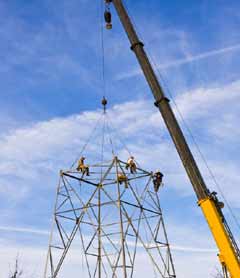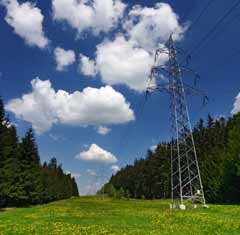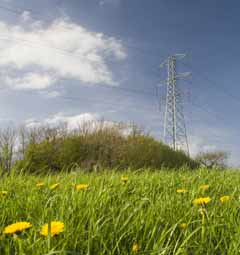 Whether meeting future energy needs involves tapping into more sources of traditional energy, renewable energy, or both, electrons cannot get to where they’re needed without transmission lines. The time span from the day a new transmission line is proposed to the day it comes on line is about 10 years. This means that planning transmission to meet the energy needs by 2020 must begin now.
Whether meeting future energy needs involves tapping into more sources of traditional energy, renewable energy, or both, electrons cannot get to where they’re needed without transmission lines. The time span from the day a new transmission line is proposed to the day it comes on line is about 10 years. This means that planning transmission to meet the energy needs by 2020 must begin now.
There are as many ways to plan, design and build a transmission system as there are ways to use the energy it provides. As the early stages begin, there are several factors that must be taken into consideration, including state and federal policies, environmental protection, size and route of the line, and the technology to be used.
State and Federal Policies
A basic overview of safety, environmental and reliability policies can be found in the State and Federal Policies section of this website.
Environmental Protection
Among the various state and federal policies governing transmission line development, two key laws focus directly on environmental concerns: the California Environmental Quality Act (CEQA) and the National Environmental Policy Act (NEPA).
CEQA
In California, CEQA requires public development projects – or private development projects that require a public permit – to follow a prescribed regimen for analyzing and disclosing potential environmental impacts of the project. Not every project requires CEQA compliance, but it’s often a safe assumption that large projects, such as transmission lines, will be subject to extensive environmental review.
At the heart of the CEQA process is a document called an Environmental Impact Report (EIR). The EIR outlines the project’s potential environmental impacts and proposes mitigation measures and project alternatives that can reduce or avoid those impacts. Fundamentally, the purpose of the EIR is to identify the best environmental alternative which, for several reasons, may indeed be the project itself.
Developing the EIR is a process that normally takes years. It is also a public process, wherein anyone can provide comments about the environmental impacts of the project. Often as the EIR process is just starting, the project’s Lead Agency (which is the public agency responsible for carrying out or approving a project subject to CEQA) will hold “scoping meetings” with the public and interested organizations to gather input on what the EIR should analyze and how it should take shape.
After the analysis is complete, a Draft EIR will be prepared and made available for public review and comment for a specified period of time. The Lead Agency may also choose to hold public hearings to receive comments on the EIR. The Lead Agency can then produce a revised Draft EIR for additional comment or proceed to a Final EIR.
There are innumerable details related to a CEQA process, much more than can be explained here. For a “simple” flowchart of the CEQA process, see page 229 of the California Natural Resources Agency’s CEQA Guidelines.
NEPA
At the federal level, NEPA directs all federal agencies to give appropriate consideration to the environmental effects of their decisions and to prepare a detailed Environmental Impact Statement (EIS) for projects that can significantly affect the quality of the environment.
 While similar to CEQA in many respects, including the protocols required for preparing the environmental document, NEPA is narrower in scope. Specifically, NEPA only applies to projects receiving federal funding or resources. Thus, it’s common to have a project that is subject to CEQA, but not NEPA.
While similar to CEQA in many respects, including the protocols required for preparing the environmental document, NEPA is narrower in scope. Specifically, NEPA only applies to projects receiving federal funding or resources. Thus, it’s common to have a project that is subject to CEQA, but not NEPA.
While there are some important differences between an EIS and an EIR (consistent with the differences between CEQA and NEPA), they are very similar documents. When both documents are required, they are often prepared together and provided to the public and regulatory agencies as a single document.
Size, Route and Technology
One of the earliest decisions when planning, building, and permitting a new transmission line involves how “large” the new transmission line will be in terms of its voltage. In high voltage transmission, the options include 230 kV, 500 kV and 765 kV (although 765 is not currently used in California). What size voltage is used depends on a few factors, including anticipated load demand and the distance between the generation resource and the load center.

As for the route, only two things are known at the beginning of the process: Point A and Point B. These are the locations of the substations that will step up the voltage from the generation resource for transmission, and step down the voltage for distribution to homes. Where and how the line gets built to connect Points A and B is often a matter of substantial discussion and debate, with every option involving its own set of planning and permitting processes.
Underlying it all, however, is a desire to choose the new transmission line route that has the least significant environmental, economic and aesthetic impacts.
Typically, a transmission line developer will begin their analysis by looking at the simplest options first, such as upgrading an existing transmission facility by employing cost-effective, more efficient technologies. This could involve upgrading a 230 kV line to a 500 kV line, or switching an AC line to DC, for example. Typically, upgrades on existing transmission facilities require no new towers, no need for new right of way (ROW), and cause little to no environmental impacts.
 If upgrading an existing transmission system is not an option, using an existing transmission line to piggyback new lines or expanding an existing ROW are the next options a developer will consider. Use of an existing transmission line in this way can cut down on cost through use of already established infrastructure, avoiding unnecessary construction and minimizing environmental impact.
If upgrading an existing transmission system is not an option, using an existing transmission line to piggyback new lines or expanding an existing ROW are the next options a developer will consider. Use of an existing transmission line in this way can cut down on cost through use of already established infrastructure, avoiding unnecessary construction and minimizing environmental impact.
Others include using an adjacent ROW or an existing, designated transportation or utility corridor, all of which would be dependent upon federal, state and local regulations.
If none of these options proves viable, a new transmission line must be built within a new ROW. This level of planning and discussion involves questions about tower configurations, underground versus overhead lines and other issues. See Transmission Line Design for more on this topic.
